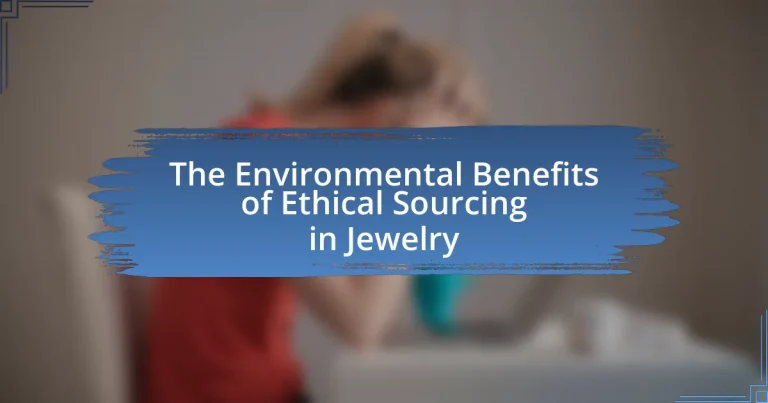The article focuses on the environmental benefits of ethical sourcing in the jewelry industry, highlighting how sustainable mining practices and responsible material sourcing can significantly reduce ecological harm. It discusses specific practices that define ethical sourcing, such as using recycled materials and ensuring conflict-free gemstones, which contribute to biodiversity conservation and lower carbon footprints. The article also addresses the challenges faced by the industry in implementing ethical sourcing and the implications of unethical practices, including environmental degradation and social injustice. Additionally, it outlines strategies for consumers to support ethical sourcing and the role of certifications in promoting responsible practices within the jewelry sector.

What are the Environmental Benefits of Ethical Sourcing in Jewelry?
Ethical sourcing in jewelry significantly reduces environmental degradation by promoting sustainable mining practices and minimizing ecological harm. Sustainable mining methods, such as those that avoid toxic chemicals and reduce land disruption, help preserve ecosystems and biodiversity. For instance, ethical sourcing often involves the use of recycled materials, which decreases the need for new mining operations, thereby conserving natural resources and reducing carbon emissions associated with extraction processes. Additionally, ethical sourcing initiatives frequently support local communities, ensuring that environmental stewardship is prioritized, which can lead to improved land management practices. This approach not only protects the environment but also fosters a more sustainable industry overall.
How does ethical sourcing impact the environment in the jewelry industry?
Ethical sourcing significantly reduces environmental harm in the jewelry industry by promoting sustainable mining practices and responsible material sourcing. This approach minimizes ecological degradation, such as deforestation and habitat destruction, often associated with traditional mining methods. For instance, according to a report by the World Gold Council, responsible gold mining can reduce carbon emissions by up to 30% compared to conventional practices. Additionally, ethical sourcing encourages the use of recycled materials, which lessens the demand for new mining and conserves natural resources. By prioritizing these practices, the jewelry industry can mitigate its environmental footprint and contribute to the preservation of ecosystems.
What specific practices define ethical sourcing in jewelry?
Ethical sourcing in jewelry is defined by practices that ensure transparency, sustainability, and fair labor conditions throughout the supply chain. Specific practices include sourcing materials from certified mines that adhere to environmental regulations, utilizing recycled metals to reduce resource extraction, and ensuring that gemstones are conflict-free, verified through initiatives like the Kimberley Process. Additionally, ethical sourcing involves fair wages and safe working conditions for miners and artisans, supported by organizations such as Fair Trade. These practices collectively contribute to minimizing environmental impact and promoting social responsibility within the jewelry industry.
How do these practices reduce environmental harm?
Ethical sourcing practices in jewelry reduce environmental harm by minimizing resource extraction and promoting sustainable materials. For instance, sourcing gemstones and metals from certified mines ensures that mining operations adhere to environmental regulations, which can significantly decrease habitat destruction and pollution. According to a report by the Responsible Jewelry Council, ethical sourcing can lead to a 30% reduction in carbon emissions compared to traditional mining methods. Additionally, these practices often involve recycling materials, which conserves natural resources and reduces waste, further contributing to environmental protection.
Why is ethical sourcing important for sustainability?
Ethical sourcing is important for sustainability because it ensures that materials are obtained in a manner that is environmentally responsible and socially equitable. This practice minimizes negative impacts on ecosystems, promotes fair labor practices, and supports local communities. For instance, according to a report by the World Gold Council, responsible sourcing of gold can reduce environmental degradation and promote sustainable development in mining regions. By prioritizing ethical sourcing, the jewelry industry can significantly contribute to the preservation of natural resources and the well-being of affected populations.
What role does ethical sourcing play in reducing carbon footprints?
Ethical sourcing significantly reduces carbon footprints by ensuring that materials are obtained through environmentally responsible practices. This approach often involves selecting suppliers who prioritize sustainable methods, such as using renewable energy, minimizing waste, and reducing emissions during production. For instance, a study by the World Gold Council indicates that responsibly sourced gold can have a carbon footprint up to 50% lower than conventionally mined gold due to improved mining practices and energy efficiency. By promoting transparency and accountability in the supply chain, ethical sourcing not only mitigates environmental harm but also encourages the adoption of greener technologies across the industry.
How does ethical sourcing contribute to biodiversity conservation?
Ethical sourcing contributes to biodiversity conservation by ensuring that raw materials are obtained in a manner that protects ecosystems and promotes sustainable practices. This approach minimizes habitat destruction and reduces the exploitation of natural resources, which are critical for maintaining biodiversity. For instance, ethical sourcing often involves adhering to regulations that prevent overfishing or deforestation, thereby safeguarding the habitats of various species. Additionally, companies that practice ethical sourcing frequently invest in community-based conservation initiatives, which can enhance local biodiversity and ecosystem health.
What are the long-term environmental benefits of ethical sourcing?
Ethical sourcing provides long-term environmental benefits by promoting sustainable practices that reduce ecological harm. This approach often involves sourcing materials from suppliers who adhere to environmentally friendly methods, such as minimizing waste, conserving water, and reducing carbon emissions. For instance, ethical sourcing in the jewelry industry can lead to the preservation of ecosystems by avoiding mining practices that destroy habitats. According to a report by the World Gold Council, responsible gold mining can reduce the environmental footprint by implementing better land management and rehabilitation practices. Additionally, ethical sourcing encourages the use of recycled materials, which decreases the demand for new raw materials and lessens the overall environmental impact.
How does ethical sourcing promote responsible mining practices?
Ethical sourcing promotes responsible mining practices by ensuring that minerals are obtained in a manner that respects environmental standards and human rights. This approach encourages mining companies to adopt sustainable practices, such as reducing ecological damage, minimizing waste, and ensuring fair labor conditions. For instance, according to the Responsible Jewelry Council, ethical sourcing frameworks require companies to adhere to strict guidelines that limit the environmental impact of mining operations and promote community engagement. By prioritizing these standards, ethical sourcing directly influences the mining industry to operate more responsibly and sustainably.
What are the implications of ethical sourcing on waste management in jewelry production?
Ethical sourcing significantly reduces waste in jewelry production by promoting sustainable practices and responsible material sourcing. When jewelers prioritize ethically sourced materials, they often engage in practices that minimize environmental impact, such as using recycled metals and responsibly mined gemstones. For instance, the use of recycled gold can reduce the need for new mining, which is associated with substantial waste generation and environmental degradation. According to a report by the World Gold Council, recycling gold can reduce the carbon footprint by up to 90% compared to traditional mining methods. Additionally, ethical sourcing encourages transparency in the supply chain, leading to better waste management practices as companies are held accountable for their environmental impact. This shift not only conserves resources but also fosters a culture of sustainability within the industry.
How can consumers support ethical sourcing in jewelry?
Consumers can support ethical sourcing in jewelry by choosing to purchase from brands that are transparent about their supply chains and adhere to ethical practices. By selecting jewelry made from conflict-free materials, such as Fair Trade gold or recycled metals, consumers can ensure that their purchases do not contribute to environmental degradation or human rights abuses. Research indicates that the jewelry industry is a significant contributor to environmental harm, with mining practices often leading to deforestation and pollution. Therefore, supporting companies that prioritize sustainable sourcing not only promotes ethical labor practices but also helps mitigate the environmental impact associated with traditional mining methods.
What challenges does the jewelry industry face in implementing ethical sourcing?
The jewelry industry faces significant challenges in implementing ethical sourcing, primarily due to a lack of transparency in supply chains. Many gemstones and metals are sourced from regions with poor regulatory oversight, making it difficult to verify the ethical practices of suppliers. Additionally, the complexity of global supply chains often involves multiple intermediaries, which can obscure the origin of materials and complicate efforts to ensure ethical standards are met. According to a report by the Responsible Jewelry Council, over 70% of consumers express concern about the ethical implications of their purchases, yet only a small percentage of jewelry companies can provide verifiable proof of ethical sourcing. This gap highlights the industry’s struggle to align consumer expectations with actual sourcing practices.

What are the specific environmental impacts of unethical sourcing in jewelry?
Unethical sourcing in jewelry leads to significant environmental impacts, including deforestation, habitat destruction, and pollution. For instance, mining activities often result in the clearing of vast forest areas, which disrupts ecosystems and contributes to biodiversity loss. Additionally, the use of toxic chemicals, such as mercury and cyanide, in gold and gemstone extraction contaminates soil and water sources, adversely affecting local wildlife and communities. According to a report by the United Nations Environment Programme, illegal mining operations can lead to the release of up to 1,000 tons of mercury into the environment annually, further exacerbating environmental degradation.
How does unethical sourcing contribute to environmental degradation?
Unethical sourcing contributes to environmental degradation by promoting practices that exploit natural resources without regard for ecological balance. For instance, mining for gemstones often involves deforestation, habitat destruction, and soil erosion, which disrupt local ecosystems. According to a report by the United Nations Environment Programme, illegal mining activities can lead to the loss of biodiversity and significant pollution of water sources due to the use of toxic chemicals. Furthermore, unethical sourcing practices frequently disregard regulations designed to protect the environment, leading to long-term ecological damage and contributing to climate change.
What are the effects of mining on ecosystems?
Mining has significant negative effects on ecosystems, including habitat destruction, soil degradation, and water pollution. The extraction process often leads to deforestation and the removal of vegetation, which disrupts local wildlife habitats and biodiversity. For instance, the World Wildlife Fund reports that mining activities can lead to the loss of up to 90% of forest cover in certain areas, severely impacting species that rely on these ecosystems. Additionally, mining operations can contaminate nearby water sources with heavy metals and toxic chemicals, adversely affecting aquatic life and drinking water quality for surrounding communities. Studies have shown that mining can lead to increased sedimentation in rivers, which harms fish populations and disrupts aquatic ecosystems.
How does unethical sourcing affect water resources?
Unethical sourcing significantly depletes and contaminates water resources. Practices such as illegal mining and industrial agriculture often lead to over-extraction of water from local sources, resulting in reduced availability for communities and ecosystems. For instance, the mining of gemstones and metals can introduce toxic chemicals into nearby water bodies, harming aquatic life and making water unsafe for human consumption. According to a study by the United Nations Environment Programme, mining activities can lead to a 70% reduction in water quality in affected areas, illustrating the severe impact of unethical sourcing on water resources.
What are the social implications of unethical sourcing on the environment?
Unethical sourcing has significant social implications on the environment, primarily leading to environmental degradation and social injustice. When companies engage in unethical sourcing practices, they often exploit natural resources without regard for ecological balance, resulting in deforestation, loss of biodiversity, and pollution. For instance, the mining of precious metals and gemstones can lead to habitat destruction and soil erosion, which adversely affects local communities that rely on these ecosystems for their livelihoods. Furthermore, unethical sourcing often involves labor exploitation, where workers are subjected to poor working conditions and inadequate wages, exacerbating social inequalities. According to a report by the United Nations Environment Programme, unsustainable mining practices can displace communities and disrupt social structures, highlighting the interconnectedness of environmental health and social well-being.
How does unethical sourcing impact local communities and their environments?
Unethical sourcing negatively impacts local communities and their environments by leading to exploitation, environmental degradation, and social instability. For instance, mining operations that disregard ethical practices often result in deforestation, water pollution, and loss of biodiversity, which directly harm local ecosystems. A study by the World Bank indicates that unregulated mining can lead to a 70% reduction in forest cover in affected areas, disrupting both wildlife habitats and the livelihoods of communities dependent on these resources. Furthermore, unethical sourcing practices can perpetuate poverty and inequality, as profits are often siphoned off by multinational corporations rather than benefiting local populations. This creates a cycle of economic disadvantage and social unrest, undermining community cohesion and resilience.
What are the consequences of labor exploitation in unethical sourcing?
Labor exploitation in unethical sourcing leads to severe social and economic consequences, including human rights violations, perpetuation of poverty, and environmental degradation. Workers often face unsafe conditions, low wages, and lack of rights, which can result in physical and psychological harm. For instance, the International Labour Organization estimates that 25 million people are victims of forced labor globally, highlighting the scale of exploitation. Additionally, unethical sourcing practices contribute to environmental harm, as companies may prioritize profit over sustainable practices, leading to deforestation and pollution. This cycle not only affects the workers but also undermines community development and ecological balance, creating long-term detrimental effects on both society and the environment.

How can the jewelry industry transition to more ethical sourcing practices?
The jewelry industry can transition to more ethical sourcing practices by adopting transparent supply chains and utilizing certified materials. Implementing traceability systems allows companies to verify the origins of gemstones and metals, ensuring they are sourced from responsible mines that adhere to environmental and labor standards. For instance, the Responsible Jewelry Council provides certification for companies that meet ethical sourcing criteria, promoting accountability. Additionally, the industry can invest in recycled materials, which significantly reduce the environmental impact associated with mining new resources. According to a study by the World Gold Council, using recycled gold can lower carbon emissions by up to 90% compared to newly mined gold. By prioritizing these practices, the jewelry industry can enhance sustainability and ethical responsibility.
What strategies can be employed to promote ethical sourcing?
To promote ethical sourcing in jewelry, companies can implement strategies such as establishing transparent supply chains, conducting regular audits, and collaborating with certified ethical suppliers. Transparent supply chains allow consumers to trace the origin of materials, ensuring they are sourced responsibly. Regular audits help verify compliance with ethical standards, reducing the risk of exploitation and environmental harm. Collaborating with certified ethical suppliers ensures that materials meet established ethical criteria, which can enhance brand reputation and consumer trust. According to a 2021 report by the Responsible Jewelry Council, companies that adopt these strategies can significantly reduce their environmental impact and improve social conditions in sourcing regions.
How can technology aid in ethical sourcing practices?
Technology can aid in ethical sourcing practices by enhancing transparency and traceability in supply chains. For instance, blockchain technology allows for secure and immutable records of transactions, enabling consumers and businesses to verify the origins of materials used in jewelry. A study by the World Economic Forum highlights that blockchain can reduce fraud and increase accountability, as it provides a clear audit trail from mine to market. Additionally, data analytics can identify and assess supplier compliance with ethical standards, ensuring that sourcing practices align with environmental and social responsibility. This integration of technology not only promotes ethical sourcing but also fosters consumer trust and supports sustainable practices in the jewelry industry.
What role do certifications play in ensuring ethical sourcing?
Certifications play a crucial role in ensuring ethical sourcing by providing a standardized framework that verifies compliance with ethical practices. These certifications, such as Fair Trade and Responsible Jewelry Council, establish criteria for labor rights, environmental sustainability, and fair trade practices, ensuring that sourced materials meet specific ethical standards. For instance, the Responsible Jewelry Council’s certification requires adherence to principles that promote responsible sourcing and environmental stewardship, thereby enhancing transparency in the supply chain. This verification process helps consumers make informed choices and encourages companies to adopt ethical practices, ultimately contributing to the environmental benefits associated with ethical sourcing in the jewelry industry.
What are the best practices for consumers when choosing ethically sourced jewelry?
Consumers should prioritize transparency and certification when choosing ethically sourced jewelry. This involves selecting brands that provide clear information about their sourcing practices and materials, ensuring they adhere to ethical standards such as Fair Trade or Responsible Jewelry Council certifications. Research indicates that ethical sourcing can significantly reduce environmental impact, as it often involves sustainable mining practices that minimize ecological damage. Additionally, consumers should consider the lifecycle of the jewelry, opting for pieces made from recycled materials, which can further decrease resource depletion and pollution. By focusing on these best practices, consumers can make informed choices that support ethical and environmentally friendly jewelry production.
How can consumers identify and support brands committed to ethical sourcing?
Consumers can identify and support brands committed to ethical sourcing by researching certifications and labels that indicate responsible practices. For example, brands that are certified by organizations like Fair Trade or the Responsible Jewelry Council demonstrate adherence to ethical sourcing standards, ensuring that materials are obtained in a manner that respects both the environment and labor rights. Additionally, consumers can look for transparency in supply chains, as brands that openly share information about their sourcing practices are more likely to be committed to ethical standards. According to a 2021 survey by Nielsen, 66% of global consumers are willing to pay more for sustainable brands, highlighting the demand for ethical sourcing in the market.


